Who are your best clients… Is there one that springs to mind immediately?
You’d be surprised to find out that this wonder client you’re thinking of may not be your “best” client. In reality, your most profitable clients are invariably not your highest paying clients.
What makes a client “good” anyways?! More importantly, how can you start to shave down your client roster to those “best” performers, and try to weed out the more difficult clients in the process?
That, and more below. Keep reading!
What Is a Customer Profitability Analysis?
Simply put, CPA is a process by which an agency will use data about each client to differentiate between the most and least profitable. These same strategies can also help provide insight into products, service-lines, or other areas of our business that are performing better, or indeed worse, than others.
What we see far too often is pressure on the sales team to sell more – to increase revenue and therefore profit. However, in reality, what could actually be happening is that your agency is experiencing indigestion trying to service certain clients, which could come from a multitude of factors.
Why You Should Calculate Customer Profitability
The simple goal of this analysis is to identify which clients are most or least profitable, at any given time. Once pinpointed, you can identify opportunities to re-negotiate terms, replace revenue, or downsize your business – all while improving profitability. Doing this helps you to paint a picture in your head depicting your “ideal” client, such as the services they offer, the way they communicate, etc.
Conversely, this is equally useful to weed out the clients that may not mesh well with your agency. It’s entirely possible that you realize a group of clients is the least profitable. From there, you can map similar traits or trends exhibited by such clients which render them a “bad fit” for your agency.
How to Perform a Customer Profitability Analysis
There are several ways to perform customer profitability analysis. In this post, we’ll focus on the simplest/least expensive methods that can give you 80% of the insight with 20% of the work.
The three ways to perform a customer profitability analysis are as follows…
- Average Billable Rate (ABR) Analysis: Fastest, easiest, and least expensive. What’s the catch? It’s the least precise.
- Estimated Delivery Margin Analysis: Can still be very fast, easy, and inexpensive, but slightly more precise.
- Financial Analysis: Most precise – but also the most time-consuming and expensive…
Irrespective of your choice of method, you’re going to need to follow the steps below to reach your desired outcome.
Step 1 – Identify AGI
Firstly, you need to identify the AGI for each of your clients over a given time period. Hold up – but what is AGI?!
AGI (Agency Gross Income) represents the “true” income your agency is earning through the work that you perform. It’s closely aligned with the financial concept of Gross Profit, depending on how the financials are modeled.
The calculation for AGI is: Revenue – Pass-through Expenses
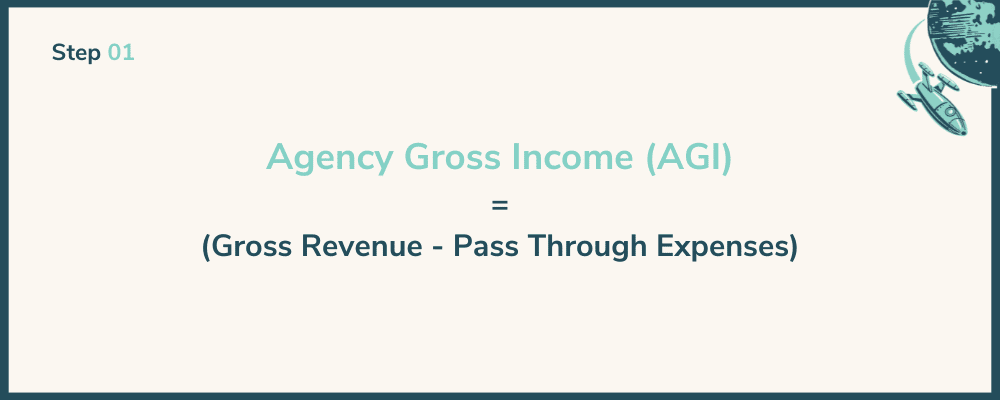
Where Revenue is the fees you are charging for your services, and Pass-Through Expenses are costs for external vendors required to deliver work to end clients. It covers revenue that doesn’t “belong” to the agency, but rather passes through to an external vendor or partner.
This includes ad-spend, print budgets, materials, stock footage, or contractor fees for work outside of the core business of the agency (for example, a video production company). It does not include contract-based resources for flexible staffing involved in core services.
Step 2 – Calculate Hours Worked Per Project
The next piece of this puzzle (again, irrespective of which method) is to obtain the number of hours worked on each client project. This can be done relatively easily using your time-tracking data.
If your team doesn’t currently track time, we’d strongly recommend it – either by using a timesheet tool or a resource-plan based methodology. Without time-tracking data, it’s nearly impossible to gain the necessary insights into questions such as how profitable your clients are! It also provides key detailed analysis, including profitability by service, project, deliverable, etc.
Here’s how to implement time tracking right from the offset. If you do track time, but still don’t have this information – you’re also going to want to click that link and get your time-tracking data structured to better answer your key questions.
Step 3 – Average Billable Rate (ABR) Analysis
Good news, if you’ve completed the above two steps, then you’ve now got what you need to run a simple Average Billable Rate (ABR) analysis!
ABR helps you understand the amount of revenue your team earns, on average, for each hour they work – in a given time period or group of client work. In this case, we’re going to look at the Average Billable Rate earned on average for each of your clients.
In order to run an ABR analysis, you’ll need to take your AGI and divide it by the number of hours worked for each client project.
The calculation for ABR is: AGI / Delivery or Billable Hours
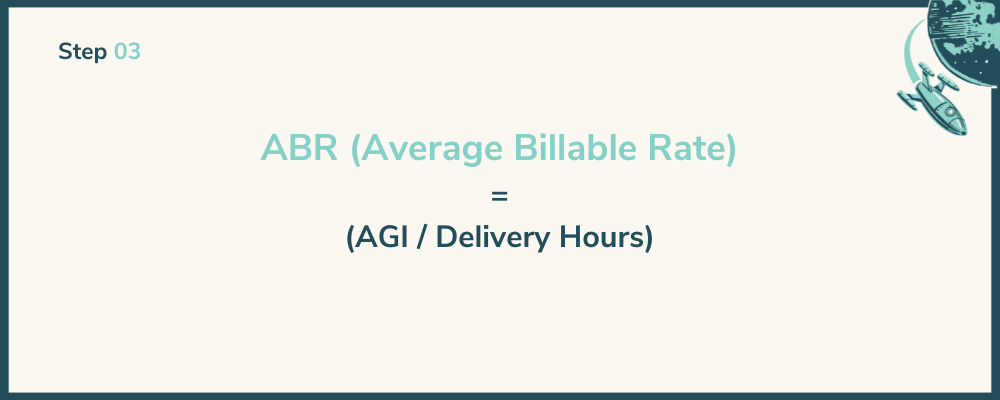
ㅤ
If you’ve got multiple projects with one client, group them together and get an average of those numbers. Get it all into a spreadsheet, and you’ll be able to compare your average rate among all clients. Generally speaking, the higher a client’s average billable rate is the more profitable they are likely to be.
Conversely, the lower their ABR, it’s more likely you’re leaving money on the table – or even losing money – working for that client.
Step 4 – Delivery Margin Analysis
If you’d like to take this analysis a step further, the next step would be to calculate the Estimated Delivery Margin for each of your clients.
In order to do this, you’ll need to calculate the Average Costs Per Hour (ACPH) for each client, then use that to get a sense of the delivery margin.
This can be as simple as using a blended ACPH for the entire team. Or you could get more granular, breaking it down for each individual team member – assigning that cost rate to each hour. Once you have a Cost-Per-Hour for each client, you can calculate the delivery margin using the following formula:
The calculation for Delivery Margin is: (ABR – ACPH) / ABR = Delivery Margin
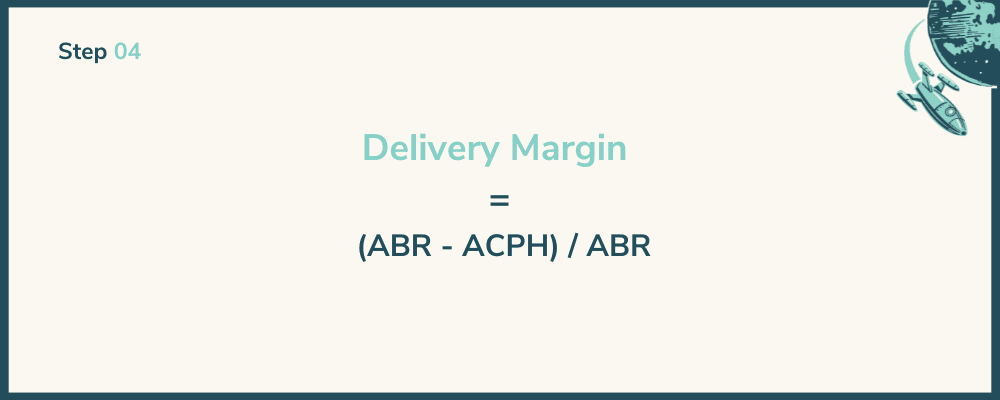
Generally speaking, the higher the delivery margin on each client, the more profitable they are. We generally encourage clients to aim for 60-70% delivery margins, or higher, on a per-client basis.
If you’d like to learn more about delivery margins and how to calculate them, check out this blog post.
Did you know?
Parakeeto offers a totally free toolkit where you can automatically generate your Delivery Margin and other profitability metrics using our Optimization Simulator. Here is what that looks like:
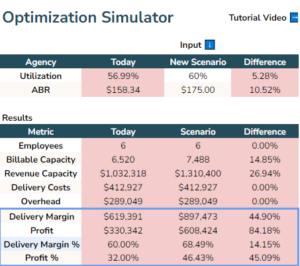
Step 5 – Financial Analysis
If you wish to be even more precise, you can try setting up your accounting system to measure client-level profitability. This is the most cumbersome way to do this and is only slightly more precise than the above methods.
Unlike prior methods, you will also need to wait until after your books are reconciled to get a read on client profitability. This is why we encourage agencies to pursue non-financial reporting as a first-step to measuring more timely and granular performance metrics in their agency.
However, if this marginal increase in precision is important to you – you’ll need to ensure all your client invoices, pass-through vendor invoices, and payroll journal entries are allocated to specific clients each time bookkeeping is performed.
All of this should be undertaken on an accrual basis for the most accurate picture of profitability. The trickiest part here will be allocating salary based on time-tracking data. This will likely add a lot of drag and expense to your accounting workflow.
Generally, we recommend measuring Delivery Margin at the client level, instead of trying to focus on “net profit”, which – in and of itself – is a flawed concept at the client, or project level (as outlined below).
The formula for Delivery Margin is the same in the financial statements as it is above. So, what’s the difference? It’s calculated as a function of AGI & Delivery Costs instead of ABR & ACPH.
The calculation for Delivery Margin on a financial basis is: (AGI – Delivery Costs) / AGI = Delivery Margin
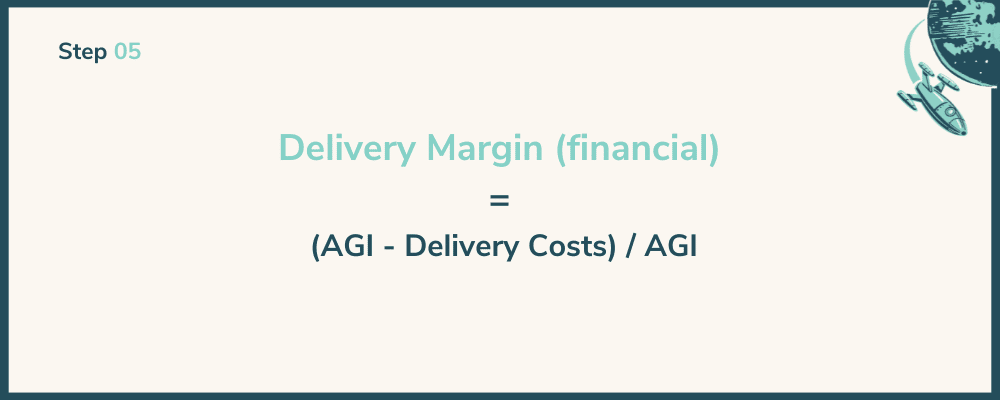
Should we measure net profit per client?
Simply put – we do not recommend trying to do this in your financial statements.
Since overhead costs generally don’t fluctuate at the same rate as revenue, overlooking delivery margin in favor of net profit margins can render it more difficult to compare client profitability, and seeing how it broadly trends over time.
In our (vast) experience, those who attempt to allocate overhead costs at client, project, or even department levels wind up spending a lot of extra time (and money) on accounting workflows. What’s more, they often end up with less useful numbers to show for it.
Often, understanding the percentage of your AGI that goes to overhead spending, and subtracting that from Delivery Margin, is a much simpler and more cost-effective way to get essentially the same insight.
In Summary
Figuring out your most and least profitable customers can be an extremely rewarding exercise, and depending on the level of granularity you seek, can also be an easy agency metric to calculate. If your team is tracking their time, or if (in some roundabout way) you can find how many hours you’re spending to deliver each project, you’ll garner an idea of who are your “best” and “worst” clients.
The next step is to decide what you’re going to do about it – now that you know you have these all-star clients you want to keep around, and a not-so-great list of clients you’d like to eventually replace.
In this guide to improving your agency’s profit margin, we delve a little deeper into revenue replacement plus investigate other levers you can pull to bring up your margins to make your agency a profit machine!








0 Comments